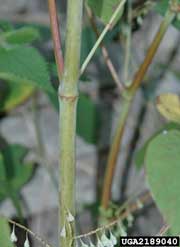
|
Among common weeds, autumn olive, Japanese knotweed, and milkweed are some of the most pernicious.
And delicious!
Incredibly invasive, they’re hard to kill. So, if you can’t beat ‘em, eat ‘em.
Russ Cohen is the rivers advocate for the Massachusetts Department of Fish and Game, and the author of the book, Wild Plants I Have Known and Eaten, published by the Essex County Greenbelt Association in northeastern Massachusetts.
Autumn Olive Berry … Fruit Leather
He leads foraging walks throughout New England. During an orientation chat before each walk, Cohen generally serves strips of “fruit leather,” made of the dehydrated pulp of autumn olive berries, with no additional sugar or other flavoring.
|
It tastes fabulous, fruity and sweet with a touch of tartness. And autumn olive berries have 18 times more lycopene than tomatoes.
The powerful antioxidant is believed to help in the prevention of heart disease and prostate cancer.
Though Cohen uses a $60 dehydrator to make his fruit roll-ups, a cookie sheet in a warm oven will also do the trick with autumn-olive pulp puree.
In its liquid form, the puree is a perfect topping for ice cream, pancakes, and johnnycakes.
After the first frost, autumn olives are super-sweet treats, eaten out of hand right off the bush.
The invasive alien’s bright-red berries are flecked with gold, and they are generally found along the road and in abandoned gravel banks.
Japanese Knotwood … Asparagus’ Cousin?
Another invasive alien, Japanese knotweed, is virtually indestructible.
 © Chris Evans, River to River CWMA, Bugwood.org Get Wild! Staking The Wild Asparagus and Stalking The Blue-Eyed Scallop by Euell Gibbons Foraging New England by Tom Seymour Wild Edible Plants of New England by Joan Richardson Invasive species recipes from The Invasive Plant Atlas of New England’s (IPANE). |
In the spring, its shoots taste like fresh asparagus lightly sprinkled with lemon juice. The shoots are best when their first leaves are still huddled together in the shape of a spear tip, and the shafts are crisp enough to crack off. Steam them for only a minute or so, add a little butter, and have a feast.
During a walk at the Tower Hill Botanic Garden in Boylston, Massachusetts, Cohen said the tender tips of Japanese knotweed also make a tasty pie used instead of rhubarb.
Related to buckwheat, Japanese knotweed is one of the last plants to blossom in late summer – early autumn in New England. Honey bees use its nectar, mixed with goldenrod nectar, to produce a honey as black as motor oil with a strong, distinctive flavor. It’s good for sweetening baked beans and for brewing unusual beers and mead.
Milkweed Meals
During his walk at the botanic garden, Cohen had high praise for milkweed, a plant that offers three opportunities for harvest:
1. when its shoots first emerge in spring
2. when its flowers begin to bud in early summer, and
3. when its seed pods first appear.
Like Japanese knotweed, the shoots of milkweed taste a little like asparagus. The flower buds are nutty and sweet, a little like pesto. Young seed pods taste like intensely flavorful green beans.
The key to cooking any of the milkweed parts, Cohen explained, is to immerse the parts into water that is already boiling. The sudden immersion into boiling water shocks the bitterness out of the plant. Boil them for seven minutes.
After boiling, use the milkweed in omelets, casseroles, soups, or by itself with a sprinkling of butter or good olive oil.
Other yummy weeds:
- Barberries in cookies
- Beach plums, in preserves and pies
- Dandelion leaves in salads, blossoms in wine, roots instead of coffee
- Jerusalem artichokes instead of potatoes
- Lamb’s quarters, steamed or fresh
- Poor man’s pepper leaves in salad, seeds for spice
- Sheep sorrel in tangy salads
- Stinging nettle in a spring-tonic soup
- Wild violet blossoms in salads or atop desserts
About the Author: Tom Meade is a writer, beekeeper and vegetable gardener in Rhode Island.






